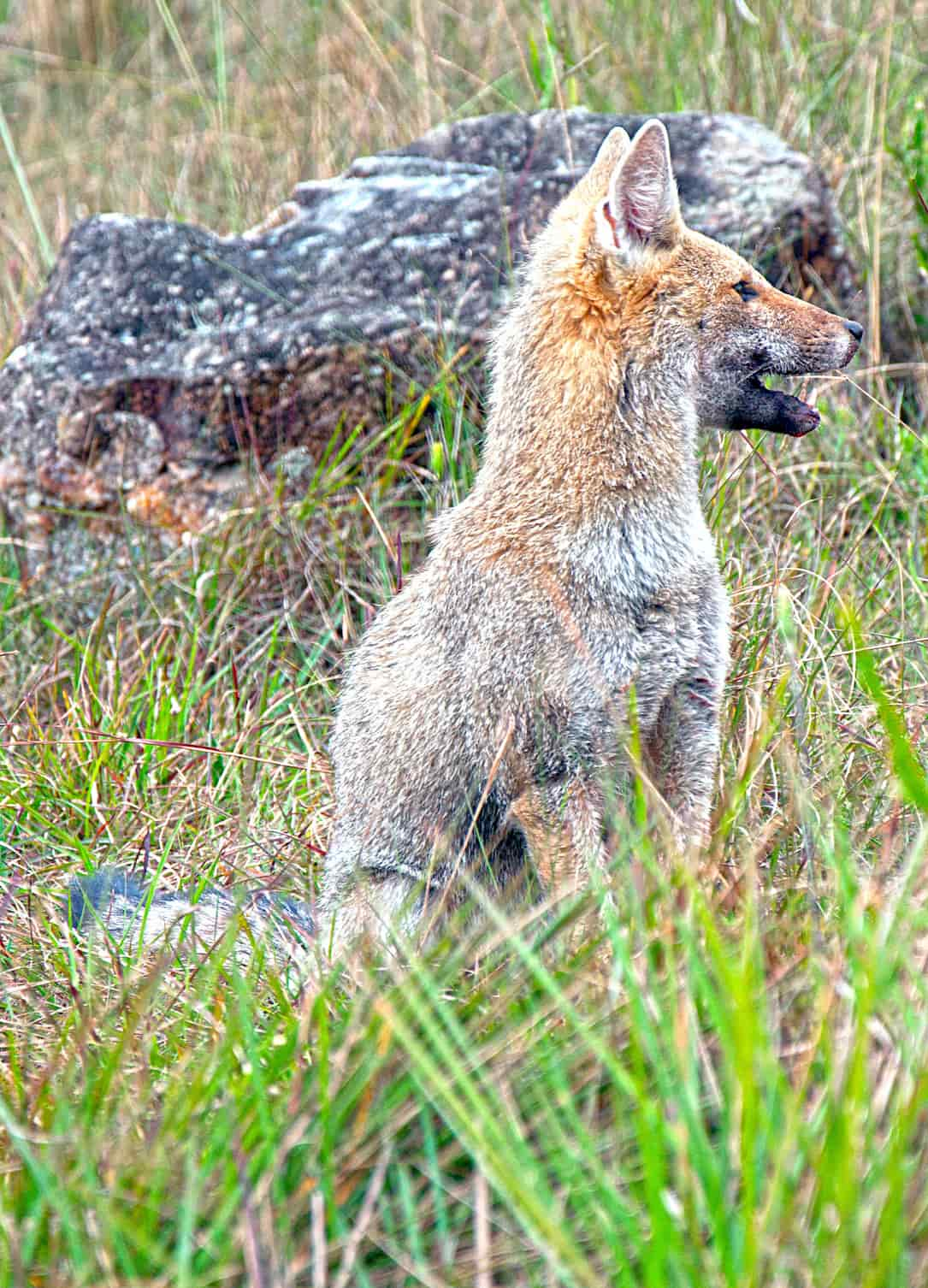- The pampas fox lives in the wet grasslands of South America.
- The Lycalopex genus is closer to wolves than foxes.
- They have a flexible diet, including insects, mammals, and birds.
The pampas fox, or Lycalopex gymnocercus as it is formally known, is a species of canid unique to the wet grasslands of Bolivia, Paraguay, Uruguay, Argentina, and southern Brazil. Sorro (from the Spanish zorro) is another name for this animal. Gotthelf Fischer first described this animal in 1814.
Because of its resemblance to “true foxes” (genus Vulpes), the pampas fox is also a South American fox (genus Lycalopex). Contrary to popular belief, members of the genus Lycalopex are more closely related to canids like wolves and jackals than they are to foxes (Vulpes).
What Is a Pampas Fox?

As a medium-sized canid, the pampas fox is only slightly bigger than its close relative, the crab-eating fox (Cerdocyon thous). The fox has many physical characteristics with the culpeo fox (Lycalopex culpaeus), including size and shape, but its nose is broader, its head and neck are covered in red fur, and its muzzle is marked with black.
It has a long face and a strong, high interparietal crest, and its skull is triangular. Their body sizes differ among regions. Adults typically measure between 5 and 18 pounds in weight and 20 and 32 inches in height.
A black stripe runs down the middle of their back and the base of their tail, while the rest of their fur is thick and gray. The crown and sides of their heads have a reddish hue.
Differentiating from the similarly colored culpeo fox, the muzzle is black up to the corners of the mouth. The outside surfaces of the triangular ears are reddish, while the inside surfaces are white. There is graying on the back, shoulders, and sides.
The tail is long (50% of the length of the body) and thick, with a darker end. Light gray to white may be seen on the belly and inner surface of the legs. Laterally, the legs are gray, but the tips are crimson. The underside of the forelimbs is a vibrant red. Northern pampas foxes in this species’ range tend to be more vividly colored. Their hind legs also have 4 toes (without a rudimentary fifth claw on their front legs).
Their Origin in Evolution

The oldest fossil record of the species is reported in the Vorohué Formation in the province of Buenos Aires, Argentina, dating back to 2.5–1.5 million years ago. Additional fossils are reported in sediments from the Luján Formation in Argentina, dating back 30,000 years.
Five subspecies are currently recognized:
- L. g. gymnocercus — G. Fischer, 1814 (north-eastern Argentina, Uruguay, Paraguay and Brazil).
- L. g. gracilis — Burmeister, 1861 (western Argentina).
- L. g. antiquus — Ameghino, 1889 (central Argentina).
- L. g. domeykoanus — Philippi, 1901 (northern Chile.
- L. g. maullinicus — Philippi, 1903 (central Chile).
Where Do Pampas Foxes Live?
Northern and central Argentina, Uruguay, eastern Bolivia, Paraguay, and southern Brazil are all home to the pampas fox. The animal is most common in open environments, especially in proximity to farming, although it has also been seen in Chaco forests, dry savannah, marsh, and mountainous woodland settings. Although the pampas fox is most often found at altitudes below 3,300 feet, it has been recorded above 11,000 feet in Puna grassland. The pampas fox is also widespread in a variety of other environments, including ridges, arid scrubland, coastal sand dunes, open woods, and cultivated and pastured land.
Their Behaviors

The routines of the pampas foxes are typically nocturnal and crepuscular. However, their patterns of behavior vary depending on where they are. The animal is nocturnal when it is isolated from other canids but diurnal when it coexists with the crab-eating fox. As another example, they are awake both day and night in Brazil.
Although they often occur alone, during the mating season they might be seen in couples. Caves, hollow trees, and even the burrows of the viscacha rabbits or armadillos (dasypodidae and chlamyphoridae) are all places they seek sanctuary. Adult pampas foxes, even when caring for young together, often hunt alone, leaving their feces in distinct locations to establish their territory. Latrines and other characteristics of defecation sites are indicative of the use of excrement in intergroup communication.
What Does a Pampas Fox Eat?
The pampas foxes have a more flexible and opportunistic diet than most other canids. They eat native fruits and vegetables, insects, small animals like hares, pampas deer cubs, and mice, and birds from the groups Tinamiformes, Passeriformes, and Columbiformes. Its diet shifts have been linked to human interference in its natural environment and prey availability. This fox sometimes eats dead animals.
Armadillos, opossums, lizards, fish, mollusks, crabs, and scorpions are all examples of bigger prey that they may eat. In Brazil, L. gymnocercus shares several food items with the crab-eating fox; however, the latter is a more frugivorous species. The Geoffroy’s cat (Leopardus geoffroyi) and the pampas cat (Leopardus colocola) may compete with the pampas fox for the same food sources. Domestic dogs and cougars are the main predators of this fox.

Potential Threats
The pampas fox is widespread in rural regions and seems to be tolerant of human disturbance. However, the pampas fox is on Appendix II of CITES, despite being classified as “Least Concern” by the IUCN on a worldwide scale.
Paraguay and Uruguay have laws protecting the pampas foxes; however, they also allow for limited hunting. Even though the species is legally protected in Brazil, it is often killed for its fur and subjected to direct persecution, particularly in rural regions. In 1983, it was deemed safe for consumption, and trading was outlawed in Argentina. The species is still being targeted by poachers because its fur is in high demand.
Even in countries where hunting is prohibited, the species is regularly pursued because of accusations that it preys on domestic poultry and sheep. Poisoning, stoning, and shooting are all forms of direct persecution. Since the pampas fox is a versatile predator that seldom targets domestic cattle, there is nothing to worry about in terms of predation. Given the lack of data on their population dynamics in rural habitats, the accumulation of these activities might initiate the potential extinction of this species.
State officials in the Brazilian State of Paraná have issued a red warning for the pampas fox because of threats to its survival, including habitat loss owing to the expansion of monoculture crops like soy and pine, as well as hunting of the animal and its natural prey. Another big threat to natural grasslands is cattle roaming freely.
Dog-Pampas Fox Hybrid

Two universities in Brazil, the Federal University of Rio Grande do Sul and the Federal University of Pelotas, made headlines in 2023 when they revealed the discovery of a dog-pampas fox hybrid.
It was discovered at the Veterinary Hospital at the Federal University of Rio Grande do Sul in 2021 after the animal had been injured by a vehicle in the municipality of Vacaria and rescued by the Environmental Patrol.
The researchers have not yet calculated the effect of this first-ever occurrence of a hybrid between a domestic dog and a fox endemic to South America, but they are already suggesting keeping dogs away from protected regions.






